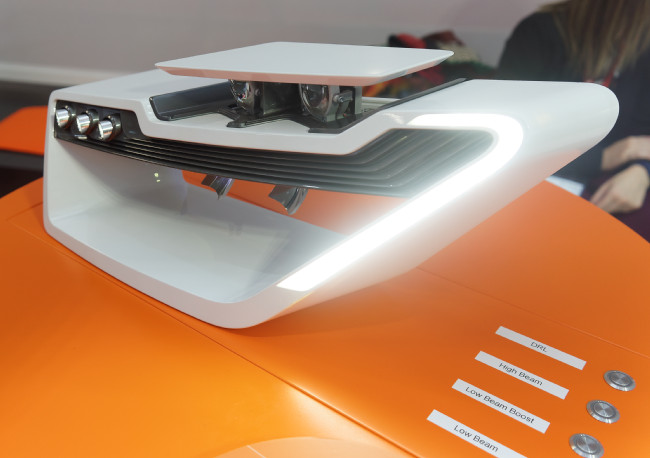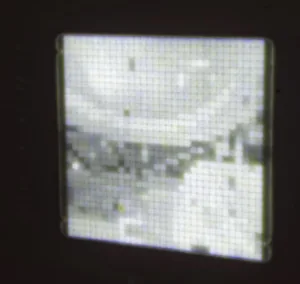Osram is a successful local supplier of LEDs that is doing well in the market at the moment. It had a big booth that was mostly about applications other than displays. The first application that we looked at was a new light for stadiums that uses 217 individual LEDs to provide 100,000 lumens of output, the first time, apparently that an LED light has been at that level and the unit has been developed by Ayrton. It can be supplied with RGB control or with white. By using a mixture of different LEDs, the colour temperature can be changed and programmed. One of the first applications is apparently in soccer stadiums.
There were a number of demonstrations of LED arrays that can be controlled at the pixel or area level and which are finding applications in the automotive market. There are arrays that are designed in two regions, for headlights, with one region being dimmed for ‘dipping’. However, Osram also showed a much higher resolution version that can be used with a camera so that where the camera detects pedestrians or oncoming cars, a ‘hole’ in the beam is created that is close to the shape of the object. This means illumination of the rest of the scene for the driver.
Osram is developing pixel array LEDs that can be used as HUD displays without needing DLP Imagers. Image:Meko
There was a demonstration of an automotive HUD that is based on a standard TI DLP engine (0.3″ imager with 864 x 480 resolution and using Osram Ostar LED to produce a maximum brightness of 34,000 cd/m² in the eye box (11.8 deg x 3.6 deg), but Osram was also showing a 1,000 pixel (36 x 36 array) muAFD array that is addressable directly and was being used to show images from a camera. The next step is to move to 2,000 pixels, at which point, Osram believes that the resolution will be enough for a simple HUD application, but without the need for a separate imager. (At one point we saw one foolhardy visitor decide to look into the beam. I can confirm that he thought it was bright! It reminded me of the sign in the laser laboratory ‘please do not look into the laser with your remaining eye’!) The LED chips are built on a substrate from Infineon which handles the driving.
Another development was the use of laser diodes being used with phosphor to create lights with a high level of performance and very even illumination, even in shapes that might be difficult or expensive for traditional LEDs, but popular, of course, with automotive designers!
 This automotive design study shows an Osram LED with remote phosphor. Image:Meko
This automotive design study shows an Osram LED with remote phosphor. Image:Meko
Osram also has a range of infrared LEDs including items that can be used for creating structured light for machine vision applications and also for gaze recognition and head and gaze tracking to detect drowsiness in drivers and motion in VR applications. They are used in the HTC Vive motion tracking.
Although we were unable to get many details about it, Osram claims that it has a new binning technology for LEDs that helps to get better white LEDs that are more evenly matched when viewed by different viewers and using the CIE 10 deg observer model. The main application is currently lighting and it’s available on the Soleriq S13 LED array.
Osram was also showing its Displix, Multiled and Multi ChipLED LEDs that are being used in LED displays. The Displix products are available in different packages which can produce highest brightness or highest contrast. There was also a demo of the LE x P1W LED that is designed to work well in home cinema projectors and is used by LG in its UST projectors.
LED is becoming a bigger business and Osram told us that it believes that it is consolidating with less than top tier vendors struggling to stay in the business.

